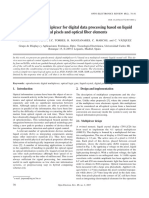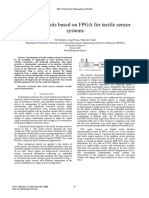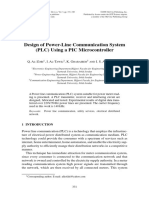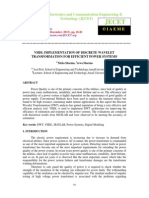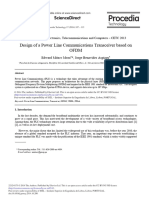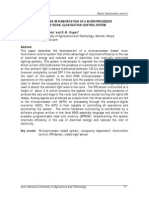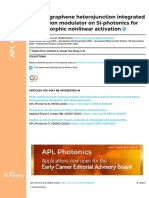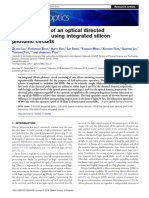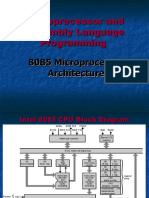Optical Mux
Optical Mux
Uploaded by
prakashrs295Copyright:
Available Formats
Optical Mux
Optical Mux
Uploaded by
prakashrs295Copyright
Available Formats
Share this document
Did you find this document useful?
Is this content inappropriate?
Copyright:
Available Formats
Optical Mux
Optical Mux
Uploaded by
prakashrs295Copyright:
Available Formats
OPTO-ELECTRONICS REVIEW 15(2), 7881
DOI: 10.2478/s11772-007-0003-y
Optoelectronic multiplexer for digital data processing based on liquid crystal pixels and optical fiber elements
I. PREZ, J.M.S. PENA*, J.C. TORRES, R. MANZANARES, C. MARCOS, and C. VZQUEZ Grupo de Displays y Aplicaciones Fotnicas, Dpto. Tecnologa Electrnica, Universidad Carlos III, Butarque 15, E-28911 Legans, Madrid, Spain
In this work, we present an optoelectronic digital multiplexer 4:1 based on a multipixel nematic liquid crystal cell. This device uses two optical control signals to select one among four possible optical data inputs. These data signals are generated by four red LEDs, which are guided through plastic optical fiber towards liquid crystal pixels. For our purpose, only four pixels of the cell will be used to modulate the optical signal across them. Each pixel will be addressed by a square waveform coming from the conditioning circuit managed by a microcontroller system. The electronic control allows the multiplexer to work as simple two input logical gates such as AND, NAND, OR, NOR, XOR and XNOR. The operation time of the device is limited by the response time of LC cell that is in the millisecond range.
Keywords: optoelectronic digital multiplexer, optical logic gate, liquid crystal, digital processing.
1. Introduction
Optical information systems have been the object of an extensive research activity in the last years. Historically, electronics and optical information systems were developed separately and with no significant interaction between them. Although optical systems are able to perform the process in parallel of the information, they have been limited by the difficulty of introducing or extracting the information from optical signals on real time. These factors have drastically changed in the last decades due to the raise of optoelectronics. This technological branch permits the integration between electronics and optical technology providing a new path to produce a number of devices that allow for generation, detection and optical signal control. A relevant number of optoelectronic devices includes liquid crystals (LCs) as integrating components among many other innovative materials [1]. They have many unique and useful physical and optical properties allowing fabrication of technologically important electrooptical devices [2]. A number of interesting applications is related to the capability of handling in parallel the optical signal in optical information systems [3]. Liquid crystal devices can offer such performance although their speed of response is typically on the order of millisecond. This is not always sufficient for signal processing, but sometimes useful in such applications as low data rate information systems, or preprocessing step in hybrid computing schemes [4].
2. Design and implementation
The description of multiplexer components and the electronic control system are showed in the two next subsections. Unlike other proposals [5], where the control inputs of the multiplexer were electronic signals, this multiplexer can be considered an all-optical system from a functional point of view. However, several steps of optical-electronic conversion are necessary inside the system to carry out the logical information processing.
2.1. Multiplexer design
A twisted nematic liquid crystal display (TN-LCD) has been used to implement the 4:1 optical multiplexer (OMUX). The display is formed by a multiplexed 44 matrix configuration. The size of display is 1010 mm and the thickness is 12 m. The active area of a pixel is 2.22.2 mm. Each pixel of this device, placed between crossed polarizers, shows the electro-optic (E/O) response represented in Fig. 1. By applying a voltage on the pixel, liquid crystal molecules realign and rotate the polarization of the light passing through it. With a sufficient voltage, the light polarization rotates to an orthogonal state. A 1-kHz square waveform with variable amplitude has been applied to the LC cell and 650 nm monochromatic light has been used in order to obtain its E/O response. Optical transmission has been measured with a large area photodiode. Applied voltages below 1.2 Vrms maintain the pixel switched transparent while above 2.8 Vrms keep the pixel in the dark state. Only four pixels placed in the corners of LC cell have been used as integrating electrooptical elements for the operation
*e-mail:
jmpena@ing.uc3m.es
78
Opto-Electron. Rev. 15, no. 2, 2007
Fig. 2. Working table of a 4: 1 digital multiplexer.
Fig. 1. Experimental electro-optic response of the TN-LCD used between crossed polarizers.
of the multiplexer. The rest of pixels always remain in the dark state. The inputs (data and control) and the output ports of the multiplexer are made of commercial plastic optical fiber (POF). The POF (HFBR-E889328-C) has 1-mm core, a numerical aperture of 0.47 and 0.25 dB/m losses. Commercial plastic fiber optic red LEDs (IF-E99) supply optical data and control inputs. So, an all-optical multiplexer can be implemented by means of an optical-electronic conversion of optical control inputs. This step is necessary to switch the LC pixels that are involved in the processing of optical data supplied to the inputs of the system. Commercial plastic fiber optic phototransistors (IF-D92) and transimpedance amplifiers have been used to perform this conversion. To obtain a 4:1 multiplexer behaviour (Fig. 2) only a pixel of the TN-LCD may be switched transparent each
time, according to the control input values. The other three pixels can remain in the dark state. To carry out this behaviour, an integrated circuit (MAX333) with four 2:1 analogue multiplexers has been used. The MAX333 supplies the appropriate voltages to the rows and columns of TN-LCD to modify the optical transmission of LC pixels. A convergent lens has been used to couple the light coming from the LC matrix display towards the output POF of the multiplexer. A commercial plastic fiber optic phototransistor (IF-D92) and a transimpedance amplifier convert the optical output into an electric voltage: This voltage has been measured in a digital oscilloscope to check the right operation of the OMUX. Figure 3 shows the complete diagram of the developed prototype.
2.2. Control electronics
A digital multiplexer with appropriate width can be used to implement any combinational function. Since these logic elements can also perform sequential operations, entire digital systems can be implemented with multiplexers [5].
Fig. 3. Schematic diagram of developed prototype. Opto-Electron. Rev. 15, no. 2, 2007 I. Prez
79
In this work, an electronic control, implemented in a PCB, has been added to the optical multiplexer. This electronic control allows the multiplexer to behave like conventional two input logical gates (AND, NAND, OR, NOR, XOR, and XNOR). A software tool running on a PC has been developed for selecting the logical gate implemented and the logical value of optical signals in the inputs and output of OMUX. The main component of the electronic control is a microcontroller device (AT89C2051). This microcontroller carries out the following tasks: control of multiplexer-PC communication by means of a PC series port, control of addressing waveforms of TN-LCD, control of the LEDs driving to supply four optical data inputs (light or not light) according to the logical gate selected, to collect the voltage at the output port of multiplexer to send the result of the selected logical function to the PC. The software interface permits to show the selected logical function to the user, as well as the logical values for the input and output variables.
3. Results and discussion
A set of measurements of the two control inputs (logical function variables) of multiplexer and its output were acquired in a digital oscilloscope as it is shown in Fig. 4. Results for all logical functions checked (AND, NAND, OR, NOR, XOR and XNOR) are right. The operation time of the device is limited by the response time of LC cell that is about 5 ms. In this prototype, the multiplexer width could be easily increased and, therefore, more complex combinational functions could be implemented. On the other hand, combining in an appropriate way several 4:1 multiplexers, it would be very easy to implement different combinational and sequential logic systems such as conventional binary adders, comparators, line decoders, byte parity checkers/ generators, set-reset flip flops, among others [5]. This could permit its use in potential applications such as low data rate information systems, or pre-processing step in hybrid computing schemes, among others. In order to reduce the response time of the OMUX implemented, new configurations and liquid crystals materials are being currently tested. Promising results have been ob-
Fig. 4. Experimental results acquired in a digital oscilloscope for different logic functions. The two below traces in each plot correspond to the control inputs and the above trace is the output of the OMUX.
80
Opto-Electron. Rev. 15, no. 2, 2007
2007 SEP, Warsaw
tained using quiral smectic C* liquid crystals as integrating electrooptical elements of the multiplexer. They may act as linear retarders whose direction can be switched very quickly from being along the polarization direction of incident light to being at 45 from the polarization direction of the light. If these LC materials retard the light by a half wave, then the state of the light on reaching the exit polarizer may be changed from 0 to 90, allowing for ON (transparent) and OFF (opaque) operation modes. Nevertheless, the influence of the wavelength of the used optical signal could affect considerably the OMUX electrooptical performance limiting thus its use in practical applications.
as optical sensor networks for automotive and dynamic reconfiguration applications in telecommunications systems, among others.
Acknowledgements
This work was partially supported by the Ministerio de Educacin y Ciencia (projects TIC2003-09212-C02 and TIC2006-13392-C02-01/MIC) and Comunidad de Madrid (grant no. S-0505/ESP/000417).
References
1. J.A. Castellano, Handbook of Display Technology, Academic Press, San Diego, 1992. 2. C. Vzquez, J.M.S. Pena, I. Prez, and S. Vargas, Optical router for optical fiber sensor networks based on a liquid crystal cell, IEEE Sensors J. 3, 513518 (2003). 3. R.S. McEwen., Liquid crystals, displays and devices for optical processing, J. Phys. E: Sci. Instrum. 20, 364377 (1987). 4. W. Klaus, Y. Suzuki, M. Tsuchiya, and T. Kamiya, Accurate predictions of the electrooptic characteristics of homogeneous nematic crystal phase modulators, CLEO95, Baltimore, 1995. 5. L.E.M. Brackenbury, Multiplexer as a universal computing element for electro-optic logic systems, IEE Proc. 137, 305310 (1990).
4. Conclusions
A 4:1 optoelectronic multiplexer based on a multipixel twisted nematic LC cell is proposed. The capability of this device to implement simple logical functions operating with visible optical signals is demonstrated. The control electronics for addressing the LC pixels has been based on a microcontroller system. Operation times obtained for the most implemented logical functions are in the range of millisecond. This prototype shows a great promise in practical applications in terms of functionality and reliability. In fact, it could be integrated in more complex systems for optical processing in low data rate information systems such
Opto-Electron. Rev. 15, no. 2, 2007
I. Prez
81
You might also like
- Utl DWDM Technical Manual - Utl-Mp-0072Document207 pagesUtl DWDM Technical Manual - Utl-Mp-0072Fareed mk86% (7)
- Optical Switching TechnologyDocument7 pagesOptical Switching TechnologyKumar Goud.KNo ratings yet
- MLLNDocument13 pagesMLLNksu2006100% (5)
- Optoelectronic Multiplexer For Digital Data ProcesDocument4 pagesOptoelectronic Multiplexer For Digital Data ProcesFitra NurakbarrNo ratings yet
- Robust and Low-Cost Proximity Sensor For Line Detection Robot Using Goertzel AlgorithmDocument4 pagesRobust and Low-Cost Proximity Sensor For Line Detection Robot Using Goertzel AlgorithmGuillem Cabo PitarchNo ratings yet
- Digital Fourier Optics: Haldun M. Ozaktas and David A. B. MillerDocument8 pagesDigital Fourier Optics: Haldun M. Ozaktas and David A. B. MillerGaurav UmarNo ratings yet
- Stand-Alone Microprocessor-Based Optical Data Acquisition SystemDocument4 pagesStand-Alone Microprocessor-Based Optical Data Acquisition SystemApangshu DasNo ratings yet
- Systolic Architecture of A Viterbi Equalizer For Optical CommunicationsDocument4 pagesSystolic Architecture of A Viterbi Equalizer For Optical Communications吴昊No ratings yet
- A New Miniaturized Electronic Pill (Epille®) For Mass Medical Application With Bi-Directional Communication SystemDocument4 pagesA New Miniaturized Electronic Pill (Epille®) For Mass Medical Application With Bi-Directional Communication SystemMarka ReddyNo ratings yet
- Smart Pixel Arrays PDFDocument22 pagesSmart Pixel Arrays PDFAnil Kumar Gorantala100% (1)
- PDFDocument4 pagesPDFchaitanya sNo ratings yet
- CIRED2011 1286 Final Universidad de OviedoDocument4 pagesCIRED2011 1286 Final Universidad de OviedopipotxNo ratings yet
- Improvement of Optical Fiber Communication System Using A Parallel Interface CircuitDocument6 pagesImprovement of Optical Fiber Communication System Using A Parallel Interface CircuitHimanshu PalNo ratings yet
- Reversible Multiplexer DocumentDocument67 pagesReversible Multiplexer DocumentJEYA KRISHNANNo ratings yet
- Implementation of Digital QPSK Modulator by Using VHDL / MatlabDocument5 pagesImplementation of Digital QPSK Modulator by Using VHDL / Matlabblesson123No ratings yet
- Energy Consumption and Energy Density in Optical and Electronic Signal ProcessingDocument14 pagesEnergy Consumption and Energy Density in Optical and Electronic Signal Processingmani manisNo ratings yet
- Fiber Optics Communication enDocument50 pagesFiber Optics Communication enMinh Đức Phạm TrầnNo ratings yet
- Performance Evaluation of A Bayesian Decisor in A Multi-Hop IP Over WDM Network ScenarioDocument6 pagesPerformance Evaluation of A Bayesian Decisor in A Multi-Hop IP Over WDM Network ScenariosugengsaNo ratings yet
- Volken 1996Document10 pagesVolken 1996nevinkoshyNo ratings yet
- Performance Analysis of Scheduling Algorithms in Optical Burst Switching NetworksDocument5 pagesPerformance Analysis of Scheduling Algorithms in Optical Burst Switching Networkseditor_ijarcsseNo ratings yet
- Study of Binary Phase Shift KeyingDocument5 pagesStudy of Binary Phase Shift KeyingShivachandran NadarNo ratings yet
- Medium Voltage Electrical System ReDocument19 pagesMedium Voltage Electrical System ReBet KèoNo ratings yet
- C E Q I P: Ryogenic Lectronics and Uantum Nformation RocessingDocument38 pagesC E Q I P: Ryogenic Lectronics and Uantum Nformation RocessingJossy VegaNo ratings yet
- Pnas 201219068siDocument7 pagesPnas 201219068siSneider LandinezNo ratings yet
- Transmission Through PowerlineDocument10 pagesTransmission Through Powerlineyameogoangela2015No ratings yet
- Mode P1, P2, ES, Quiz, Assignment, Simulation AssignmentDocument5 pagesMode P1, P2, ES, Quiz, Assignment, Simulation Assignmentpraveen_warneNo ratings yet
- DocumentDocument17 pagesDocumentVaishnav AjishNo ratings yet
- Mahar Biz PaperDocument3 pagesMahar Biz PaperClark ChenNo ratings yet
- Jecet: Journal of Electronics and Communication Engineering & Technology (JECET)Document11 pagesJecet: Journal of Electronics and Communication Engineering & Technology (JECET)IAEME PublicationNo ratings yet
- Spatial Pulse Position Modulation For Optical CommunicationsDocument7 pagesSpatial Pulse Position Modulation For Optical CommunicationsbelalassabiNo ratings yet
- Aparna GupatDocument24 pagesAparna GupatAkshat SaxenaNo ratings yet
- 1 s2.0 S2212017314004368 MainDocument7 pages1 s2.0 S2212017314004368 Mainbenesseddik.abdessalemeNo ratings yet
- Switches .Of Course These Switches Are Cheap and Capable ofDocument17 pagesSwitches .Of Course These Switches Are Cheap and Capable ofK Murali KrishnaNo ratings yet
- An Efficient BER Analysis of OFDM Systems With ICI Conjugate Cancellation MethodDocument6 pagesAn Efficient BER Analysis of OFDM Systems With ICI Conjugate Cancellation Methodnayeem4444No ratings yet
- Optical LabDocument87 pagesOptical LabHesham OsmanNo ratings yet
- A Mixed Signal AsicDocument6 pagesA Mixed Signal AsicbmmostefaNo ratings yet
- The Multiply and Fourier Transform Unit: A Micro-Scale Optical ProcessorDocument20 pagesThe Multiply and Fourier Transform Unit: A Micro-Scale Optical ProcessorCoward CrowNo ratings yet
- Mechatronics 18 NovDocument10 pagesMechatronics 18 NovEsnayder teorias dragon ballNo ratings yet
- E. O. Owiti, J. N. Mutuku and R. M. Ongeri: Jomo Kenyatta University of Agriculture and Technology, Nairobi, KenyaDocument13 pagesE. O. Owiti, J. N. Mutuku and R. M. Ongeri: Jomo Kenyatta University of Agriculture and Technology, Nairobi, Kenyabhuvi2312No ratings yet
- PID Controller Using Rapid Control Prototyping TechniquesDocument11 pagesPID Controller Using Rapid Control Prototyping TechniquesAlay Camilo Lopez CastanoNo ratings yet
- Switched Beam Antenna System Design: Mohamad Kamal Abdul Rahim, Mohd Nazif Mat Salleh, Osman Ayop, Thelaha MasriDocument4 pagesSwitched Beam Antenna System Design: Mohamad Kamal Abdul Rahim, Mohd Nazif Mat Salleh, Osman Ayop, Thelaha MasriJoyce GeorgeNo ratings yet
- Mechatronics Lab Manual 18-19Document46 pagesMechatronics Lab Manual 18-19DnaneshwarNo ratings yet
- 10.1515 - Nanoph 2018 0140 PDFDocument10 pages10.1515 - Nanoph 2018 0140 PDFShourya SONI (11C)No ratings yet
- Unit 4Document23 pagesUnit 4Divyanshu AgarwalNo ratings yet
- 5.0062830 - APL Photonics - NuralDocument10 pages5.0062830 - APL Photonics - NuralRishi MaitiNo ratings yet
- Esy Report 34Document16 pagesEsy Report 34Shubham TayadeNo ratings yet
- Ijs Ron 20131047Document3 pagesIjs Ron 20131047arandomanNo ratings yet
- Digital CalenderDocument5 pagesDigital CalenderSARATH SASINo ratings yet
- Simulation and Study For Coherent Ofdm SystemDocument5 pagesSimulation and Study For Coherent Ofdm SystemTaha Al-abedNo ratings yet
- AnalogCircuitsITO13 PDFDocument128 pagesAnalogCircuitsITO13 PDFmouneshsk83% (6)
- QPSK Mod&Demodwith NoiseDocument32 pagesQPSK Mod&Demodwith Noisemanaswini thogaruNo ratings yet
- Digital Circuit Design For Generation of 155.52 MBPS, LVPECL Data For Optical Inter-Satellite LinkDocument7 pagesDigital Circuit Design For Generation of 155.52 MBPS, LVPECL Data For Optical Inter-Satellite Linkapi-19631162No ratings yet
- High Speed Smart Pixel ArraysDocument25 pagesHigh Speed Smart Pixel Arraysdeepak reddyNo ratings yet
- EIA Notes - Week 2Document7 pagesEIA Notes - Week 2BHARAT NIKKAMNo ratings yet
- MDC Project RepoDocument18 pagesMDC Project RepoRihNo ratings yet
- Liu 2018Document6 pagesLiu 2018sumanta.kundu318020No ratings yet
- Fundamentals of Switches (Photonic Switching)Document24 pagesFundamentals of Switches (Photonic Switching)Moxesh ShahNo ratings yet
- Coherent Detection Method Using DSP For Demodulation of Signal and Subsequent Equalization of Propagation ImpairmentsDocument3 pagesCoherent Detection Method Using DSP For Demodulation of Signal and Subsequent Equalization of Propagation ImpairmentsMd Ibrahim Khalil SalmanNo ratings yet
- Arduino Measurements in Science: Advanced Techniques and Data ProjectsFrom EverandArduino Measurements in Science: Advanced Techniques and Data ProjectsNo ratings yet
- Organic Light-Emitting Transistors: Towards the Next Generation Display TechnologyFrom EverandOrganic Light-Emitting Transistors: Towards the Next Generation Display TechnologyNo ratings yet
- Analog Dialogue, Volume 48, Number 1: Analog Dialogue, #13From EverandAnalog Dialogue, Volume 48, Number 1: Analog Dialogue, #13Rating: 4 out of 5 stars4/5 (1)
- Signal Integrity: From High-Speed to Radiofrequency ApplicationsFrom EverandSignal Integrity: From High-Speed to Radiofrequency ApplicationsNo ratings yet
- 100 Important Spelling Words For Grade 3Document3 pages100 Important Spelling Words For Grade 3prakashrs295No ratings yet
- 100 Important Spelling Words For Grade 1Document3 pages100 Important Spelling Words For Grade 1prakashrs295No ratings yet
- By DIN - Published On: 13th April 2018 03:21 PMDocument1 pageBy DIN - Published On: 13th April 2018 03:21 PMprakashrs295No ratings yet
- Daily GK Update: 18th November, 2015: 1. Kiren Rijiju Conferred With Disaster Risk Reduction Asia Champion Honour by UNDocument28 pagesDaily GK Update: 18th November, 2015: 1. Kiren Rijiju Conferred With Disaster Risk Reduction Asia Champion Honour by UNprakashrs295No ratings yet
- Shape Flash CardsDocument3 pagesShape Flash Cardsprakashrs295No ratings yet
- December Double Tonic 2015 1Document12 pagesDecember Double Tonic 2015 1prakashrs295No ratings yet
- Environmental Science and Engineering: Question Bank For Unit V Part ADocument1 pageEnvironmental Science and Engineering: Question Bank For Unit V Part Aprakashrs295No ratings yet
- 79e4150642f1ebef36 PDFDocument5 pages79e4150642f1ebef36 PDFprakashrs295No ratings yet
- Lost Production Time CostDocument3 pagesLost Production Time Costprakashrs295No ratings yet
- Figure 3.1 The Structure of The Step-Index Optical FiberDocument12 pagesFigure 3.1 The Structure of The Step-Index Optical FiberMalakonda ReddyNo ratings yet
- Actuators, Part Ii: Fred Donelson Kevin MckoneDocument14 pagesActuators, Part Ii: Fred Donelson Kevin Mckoneprakashrs295No ratings yet
- Index: Ex. No Name of The Experiment Page No. Cycle IDocument29 pagesIndex: Ex. No Name of The Experiment Page No. Cycle Iprakashrs295No ratings yet
- Simulated Design of Water Level Control System: January 2015Document13 pagesSimulated Design of Water Level Control System: January 2015Abdullah AdantyaNo ratings yet
- Extra Tutorial AnsDocument19 pagesExtra Tutorial Ansمحمد النقيبNo ratings yet
- COA Module 4 FinalDocument22 pagesCOA Module 4 FinalAkhil KrishnaNo ratings yet
- Quiz 4 - Mock Test 2Document10 pagesQuiz 4 - Mock Test 2Adriana Mohd SamsulNo ratings yet
- Chapter 1.1-8085 Architecture-IntroductionDocument34 pagesChapter 1.1-8085 Architecture-IntroductionBulbula Kumeda100% (2)
- EEE3342LabManual SmallDocument133 pagesEEE3342LabManual SmallBharat NarumanchiNo ratings yet
- Electronics Mechanic (Semester Pattern) : Syllabus For The Trade ofDocument41 pagesElectronics Mechanic (Semester Pattern) : Syllabus For The Trade ofMohamed SalamNo ratings yet
- VNH7040AYTR DatasheetDocument48 pagesVNH7040AYTR DatasheetStelian CrisanNo ratings yet
- Jean Philippe Monge March 10-14, 2014: Industrial Turbomachinery SystemsDocument131 pagesJean Philippe Monge March 10-14, 2014: Industrial Turbomachinery SystemsSofa ChaNo ratings yet
- HBR-01-SLG-ELE-WIR-0001 - Electrical Wiring & Schematic Diagram For Slug Catcher DraftsDocument56 pagesHBR-01-SLG-ELE-WIR-0001 - Electrical Wiring & Schematic Diagram For Slug Catcher DraftscherifyNo ratings yet
- Multiplexing and Demultiplexing-1Document6 pagesMultiplexing and Demultiplexing-1Ashwini PatilNo ratings yet
- Design and Verification of 16 Bit RISC ProcessorDocument6 pagesDesign and Verification of 16 Bit RISC Processorupvit SakariyaNo ratings yet
- Digital Electronic CircuitsDocument2 pagesDigital Electronic Circuitsmohitg04No ratings yet
- EE 466/586 VLSI Design: School of EECS Washington State University Pande@eecs - Wsu.eduDocument23 pagesEE 466/586 VLSI Design: School of EECS Washington State University Pande@eecs - Wsu.eduPhạm Đức ThuậnNo ratings yet
- Dokumen - Tips Kas 297a Maintenance Manual 006 05512 00033Document184 pagesDokumen - Tips Kas 297a Maintenance Manual 006 05512 00033plhoughtNo ratings yet
- CC442 NAQAA Form 12Document5 pagesCC442 NAQAA Form 12MuhamdA.BadawyNo ratings yet
- Review and Status of Waveiength-Division-Multiplexing Technology and Its ApplicationDocument16 pagesReview and Status of Waveiength-Division-Multiplexing Technology and Its ApplicationFree FireNo ratings yet
- Unit 1 (Coa) NotesDocument45 pagesUnit 1 (Coa) NotesmudiyalaruchithaNo ratings yet
- Digital Electronics Lab ManualDocument6 pagesDigital Electronics Lab ManualShahadat Hussain Parvez100% (1)
- DE LAB MANUAL Finalised PDFDocument55 pagesDE LAB MANUAL Finalised PDFOmkar MutalikNo ratings yet
- PCB Details SPC MksDocument61 pagesPCB Details SPC MksDharma LingamNo ratings yet
- Seminar Report 03Document26 pagesSeminar Report 03Allu AlthafNo ratings yet
- Digital Circuits & Logic DesignsDocument23 pagesDigital Circuits & Logic DesignssamNo ratings yet
- PSTrace 5.6 Manual 3Document99 pagesPSTrace 5.6 Manual 3Juan Daniel Sarmiento AbelloNo ratings yet
- Visvesvaraya National Institute of Technology Nagpur: Vlsi Design MTECH 2021-23 VHDL LabDocument24 pagesVisvesvaraya National Institute of Technology Nagpur: Vlsi Design MTECH 2021-23 VHDL LabRutvik PatelNo ratings yet
- IC 74XX SeriesDocument34 pagesIC 74XX SeriesSandeep MishraNo ratings yet
- Quiz U2Document12 pagesQuiz U2pavithra.jNo ratings yet
- CS3351 DPCO Lab Manual UpdatedDocument40 pagesCS3351 DPCO Lab Manual Updatedvishaalniranjan23No ratings yet



